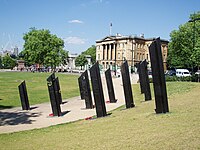
The New Zealand Film Commission is a New Zealand government agency formed to assist with creating and promoting New Zealand films. It was established under the New Zealand Film Commission Act 1978.

Te Kaha is a small New Zealand community situated in the Bay of Plenty near Ōpōtiki. The New Zealand Ministry for Culture and Heritage gives a translation of "the rope" for Te Kaha. The full name of Te Kaha is Te-Kahanui-A-Tikirākau. Te Kaha is a little outpost that contains a couple of dairies and the Te Kaha resort.

The New Zealand Symphony Orchestra (NZSO) is a symphony orchestra based in Wellington, New Zealand. The national orchestra of New Zealand, the NZSO is an autonomous Crown entity owned by the New Zealand Government, per the New Zealand Symphony Orchestra Act 2004. It is currently based in the Michael Fowler Centre and has frequently performed in the adjacent Wellington Town Hall before it was closed in 2013. It also performs in Auckland, Christchurch and Dunedin.

New Zealand is an island country in the southwestern Pacific Ocean. It consists of two main landmasses—the North Island and the South Island —and over 700 smaller islands. It is the sixth-largest island country by area and lies east of Australia across the Tasman Sea and south of the islands of New Caledonia, Fiji, and Tonga. The country's varied topography and sharp mountain peaks, including the Southern Alps, owe much to tectonic uplift and volcanic eruptions. New Zealand's capital city is Wellington, and its most populous city is Auckland.

The National War Memorial of New Zealand is located next to the Dominion Museum building on Buckle Street, in Wellington, the nation's capital. The war memorial was dedicated in 1932 on Anzac Day in commemoration of the First World War. It also officially remembers the New Zealanders who gave their lives in the South African War, World War II and the wars in Korea, Malaysia and Vietnam.
Oruaiti is a locality in Northland, New Zealand. It lies on state highway 10. Mangonui lies to the west, and Whangaroa Harbour to the east.

The Ministry for Culture and Heritage is the department of the New Zealand Government responsible for supporting the arts, culture, built heritage, sport and recreation, and broadcasting sectors in New Zealand and advising government on such.

The New Zealand War Memorial in London is a memorial to the war dead of New Zealand in the First and Second World Wars, unveiled in 2006. Officially named "Southern Stand", the memorial was designed by architect John Hardwick-Smith and sculptor Paul Dibble, both from New Zealand.

Halcombe is a small settlement in the Manawatū-Whanganui region of the North Island, New Zealand. It is situated 13 km north west of Feilding and 4 km east of the Rangitikei River, between State Highway 1 and State Highway 54.

Gladys Elinor Watkins was a New Zealand music teacher, singer, and pianist. However, she is most notable for being the first official carillonneur of the National War Memorial Carillon in Wellington.
Waimana is a rural valley in the Whakatāne District and Bay of Plenty Region of New Zealand's North Island. It is located in the northern Te Urewera. Waimana River, originally known as Tauranga River, runs through the valley, joining the Ohinemataroa River one kilometre south-west of Tāneatua.

The Canterbury Earthquake National Memorial is the Crown's official memorial for those killed or seriously injured in the 22 February 2011 Christchurch earthquake. It is located on both sides of the Avon River downstream from the Montreal Street bridge. The memorial opened on 22 February 2017, the sixth anniversary of the earthquake.

Pukeahu National War Memorial Park, also known as Pukeahu Park, is situated in front of the National War Memorial in the suburb of Mt Cook, Wellington, New Zealand. It opened on 18 April 2015 in time for the centenary of the World War I Gallipoli landings, and was one of the New Zealand Government's key projects to commemorate the 100th anniversary of World War I. The hill where the memorial was built was named 'Pukeahu' by the Ngāi Tara iwi (tribe).

Putiki is a settlement in the Whanganui District and Manawatū-Whanganui region of New Zealand's North Island, located across the Whanganui River from Whanganui city. It includes the intersection of State Highway 3 and State Highway 4.
Omakere is a farming settlement in the Central Hawke's Bay District and Hawke's Bay Region of New Zealand's North Island. It is located east of Waipawa.
Brunswick is a rural community in the Whanganui District and Manawatū-Whanganui region of New Zealand's North Island.

Lower Moutere is a settlement in the Tasman District of New Zealand's upper South Island. It is a farming community it the Lower Moutere valley, 6 km (3.7 mi) from Motueka close to the Moutere Inlet.

Patumāhoe is a small town of Auckland, New Zealand. It is in the Franklin Ward of Auckland Council.

The Abel Tasman Monument is a memorial to the first recorded contact between Europeans—led by the Dutch explorer Abel Tasman—and Māori in New Zealand's Golden Bay on 18 and 19 December 1642. It was unveiled on the tercentenary of the encounter by the prime minister, several government ministers, and a Dutch delegation. The monument, originally referred to as the Abel Tasman Memorial, was designed by the architect Ernst Plischke as an abstracted sail, and consists of a large concrete monolith painted white. Located on a bluff at Tarakohe just east of Pōhara, the land for the monument was gifted by the Golden Bay Cement Company. The dignitaries opened the Abel Tasman National Park the following day and the area holding the monument is part of the national park. As was typical for the 1940s, the original inscription focused on the European experience only and overlooked the Māori perspective, demonstrating Western-centric systemic bias. The monument is one of New Zealand's National Memorials.




























